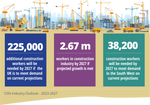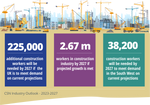What is hindering your market at the moment?
In Destination Consulting, we operate across a broad spectrum of the leisure, entertainment, culture and sporting industries, serving operational businesses and capital development projects in the private and public sectors.
The private sector has been facing significant operational cost challenges, staffing issues, high inflation and elevated interest rates, making capital investment and financing considerably more expensive. Similarly, public institutions, including museums, have struggled with operational costs and limited, increasingly competitive public capital funding opportunities. The cultural sector, much like the broader UK public infrastructure, is suffering from years of underinvestment.
In addition, the 2024 general election was a hindrance across all markets as it caused decision making and investment to slow and stall. The resolution of the election and the new Government should help stabilise sentiment helping to overcome the political instability and turmoil that has persisted since 2016.
What opportunities are you seeing in your market at the moment?
Generally speaking, demand - meaning peoples’ intention to visit places or buy tickets-has returned to pre-COVID levels. As a result, visitor numbers are finally restabilising, and with some price point inflation which has protected revenues. The opportunity therefore is to take advantage and capitalise on this renewed consumer demand, particularly by offering genuinely compelling visitor experiences and good value for money.
However, there is a tension between this rebound effect and people's disposable income as the cost of living is still high, exerting significant financial pressure on many households. This creates a fragmented market of those that can afford interesting trips and those that can’t.
One driver of the improved visitor numbers is a resurgence in the international tourist market, which particularly benefits major cities like London, Edinburgh, and Manchester. Outside of these hubs, international tourism remains minor compared to the domestic UK market. This summer, the key opportunity lies in encouraging more British residents to travel within the UK, especially across various regions.
What’s the biggest change you have seen in your sector throughout your career?
My team operates as a consulting business, offering advice and dedicating our time to clients rather than focusing on closing deals. Over the 15 years I've worked in this field, I've noticed a significant shift in client expectations. Lead times have shortened, and patience has waned, resulting in clients seeking our services at the last minute and expecting faster turnaround times. Budgets are tight, but it's not simply a matter of wanting more for less money. Clients seem to accept receiving slightly lower quality reports or studies as long as they are quicker and cheaper – a worrying trend. This trade-off for short-term gains, such as speed and affordability, comes at the expense of longer-term essentials like quality. For example, a cheaper, quicker business plan might seem advantageous today, but it proves futile if it fails to withstand investor scrutiny in the future.
What has surprised you the most about your sector post pandemic?
A noticeable shift for the sector post-pandemic is the shrinking of geographies and market locations, which has been driven by the adoption of online meetings and communication.
Moreover, an unintended consequence, is a diminished quality of team collaboration due to reduced physical presence in joint office working sessions.
Historically, our operations rarely extended to the USA or Asia/Australia due to geographical constraints and the preference for local market advisors. However, Colliers has a specialist expertise in surf park advisory, a growing, young international market – especially promising in the surf strong locations of USA and Australia.
Combining our track record and experience with the normalisation of online meetings via Teams and Zoom has given potential international clients, including those in the USA, the confidence to hire us from the UK. Clients appreciate Colliers’ global network and our team’s surf park expertise, but it is only since the pandemic that online meetings have made it feasible for us to provide advice and services internationally with ease.
However, the prevalence of online meetings brings a distinct disadvantage: the dilution of quality in team projects. With far fewer face-to-face workshop sessions, projects often lack the collaborative creativity that is crucial for success. While online meetings have enabled us to be more efficient and reach a wider client base, they shouldn’t be relied upon exclusively. In-person workshops provide a crucial element of teamwork that consistently strengthens the overall project, and unfortunately, this vital component is being eroded.
What are your predictions for the next 12-18 months, in your sector?
One of our core specialisms is surf parks. Colliers is a global market leader in surf park viability and our team is frequently addressing client questions such as: What sort of surf scheme is appropriate? Will it work? How many people might come? What is the business plan? Can we make a return on investment?
We lead this service out of the Bristol office in the UK and have worked on over 30 surf related projects worldwide over the last 10 years.`
The next 12-18 months is a crucial stage in the sector as several new openings are expected to come on to the market. Currently, there are about 10 operational surf parks globally. However, many projects have been in planning and development, with many delayed though COVID, cost inflation and high interest rates. Now that many of these issues are being resolved, we anticipate the global supply of surf parks to double, with more than 10 to open over the next 12-18 months. This includes new sites in locations such as Edinburgh, Madrid, South Carolina and Virginia.
This phase is centrally important to proving the sector’s viability and attractiveness to investors.
























